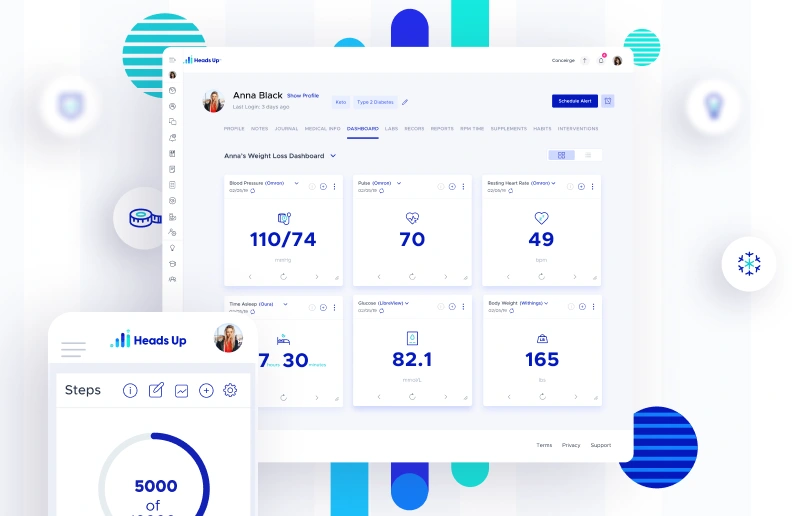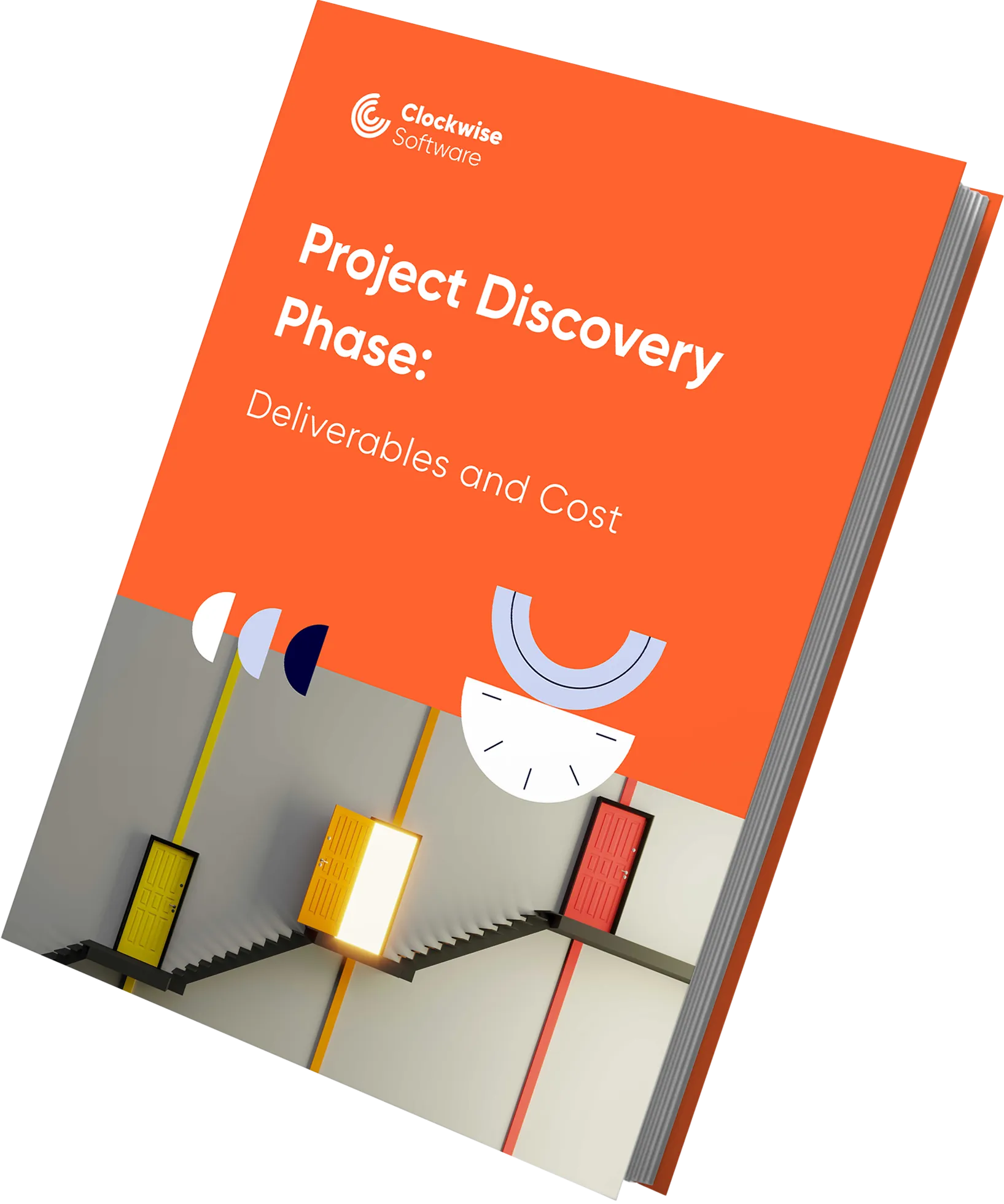Healthcare Software Development Guide: Process and Insights from 10+ Projects
Summarize:
Key takeaways
- We recommend starting a project by running a discovery stage. It is critical to define scope, integrations, and compliance needs before development starts. We skip this stage only when a client already has detailed system requirements.
- Start lean with an MVP. Focus on core features like authentication, patient data, and scheduling. This lets you validate your idea and avoid wasting budget on extras too early.
- A typical MVP takes 4–6 months. Budgets usually fall between $70K and $120K. Projects with extra features like wearables or billing need more time and higher investment.
- Plan for the long run. Post-release work usually includes monitoring performance, adapting to new compliance rules, and gradually adding features.
When you greenlight a healthcare software development project, every decision matters: which features to prioritize, what measures to implement to meet compliance, and what tech approach to use. Getting this balance right defines whether your app can scale smoothly or stalls after launch.
And we know how to get healthcare products right. Since 2014, we’ve built over 200 apps from the ground up, including more than 10 healthcare software development services projects, from early-stage startups with bold ideas to established medical companies with strict requirements.
One example is Heads Up, a health tracking solution for clinicians and patients. We’ve partnered with them for over four years, supporting the platform as it expanded to thousands of users worldwide.
Projects like this have shown us what really matters in healthcare software development, and in this article, we’ll share the lessons we’ve learned: the steps, choices, and practices that will help you build a product that’s safe, compliant, and ready to make an impact.
What makes a great healthcare software?
In 2025, the basics (security, HIPAA/GDPR compliance, decent performance) won’t win you points. They’re the bare minimum. Skip them, and neither users nor investors will take you seriously.
The winners are the products that follow healthcare technology trends and mix rock-solid tech with everyday healthcare workflows. Here are some common traits that set successful healthcare platforms apart.
Clear value for each role
Healthcare apps juggle a lot of roles at once: doctors, patients, caregivers, insurers, admins. Each of them opens the app with a different goal in mind, and none of them should have to click around to find it.
The products that stand out are the ones that respect people’s time, cutting the clutter, guiding them straight to what matters, and making critical actions feel almost effortless. For a patient, that’s a clear snapshot of progress. For a clinician, it’s pulling up lab results in seconds between appointments. The less friction in the flow, the more trust the product earns.
Built for scale and long sessions
Unlike consumer apps, healthcare platforms don’t get opened for a quick scroll and closed again. They’re often running for hours, side by side with other systems, while clinicians are mid-shift or patients are logging data. Survival in healthcare software means staying stable under constant pressure. A well-built app can take a sudden traffic surge in stride (imagine thousands of patients submitting lab results at once) without draining devices or crashing when it matters most.
Integration instead of isolation
Modern healthcare software can’t live in a bubble. It has to plug into the bigger ecosystem: EHRs, wearables, labs, payment providers, even decades-old hospital systems still running in the background. The difference between a product that fades into “just another silo” and one that becomes essential is simple: seamless integration. The smoother the connections, the more the platform feels like part of the workflow instead of another tool people have to wrestle with.
Trust through transparency
Encryption keeps data safe, but it doesn’t build trust on its own. Trust grows when an app communicates clearly, showing users what’s happening instead of keeping them in the dark. Simple things like reliable notifications, visible system status, and straightforward error messages can calm anxious patients and help clinicians move faster. When people feel the remote patient monitoring app is open with them, they see it as safer, more professional, and worth relying on.
Of course, knowing what makes a product great is just the starting point. The next question is how to actually build it, step by step, without missing the things that matter most in custom healthcare software development.
Healthcare software development stages
Turning a healthcare idea into a product takes three stages:
-
Discovery: a stage where we map the vision, test assumptions, and set the roadmap.
-
Development: our team builds secure, scalable features around real clinical and business needs.
-
Post-release support: we stay on board to keep the product stable, compliant, and evolving as user needs change.
Here’s what our team does on each stage of custom healthcare software development and why it matters.
Discovery for healthcare apps
Skipping the discovery phase might feel like saving time, but it’s usually the costliest mistake. This stage turns a vague idea into a clear, validated plan for development.
Everything starts when we jump on a call with you to understand your vision and priorities. With your answers, we can then map features and user flows, define necessary integrations, design the UX/UI, and finally outline the technical approach and architecture. By the end of discovery, you get more than documents:
-
Defined scope, user journeys, and clear feature requirements aligned with your vision.
-
Wireframes and prototypes to visualize the experience.
-
A technical blueprint that outlines the tech stack, right architecture (monolith, microservices, or serverless), and the integrations your product depends on.
-
A realistic roadmap and estimate, including a software development risks register that flags potential issues before they can become expensive rework.
Beyond the roadmap, we also dig into the core building blocks of healthcare software.
Must-have things we consider for healthcare products
There are a few must-haves we always check off first: your existing systems, necessary integrations, compliance, security, and accessibility. Here’s what we do:
-
Auditing the current infrastructure. Before choosing a tech approach to healthcare software product development, we look at what you already have: hospital systems, databases, APIs, or legacy setups. This gives us a clear picture of what can be reused, what needs replacing, and where risks might hide.
-
Choosing the right integration approach. We weigh options like HL7/FHIR standards, middleware, or custom APIs to find the balance between smooth data flow, compliance, and long-term scalability.
-
Running proof-of-concepts. When there’s uncertainty (say, connecting to an old EHR or integrating a wearable), we build small PoCs to test the tricky parts. Better to invest a week proving it works than months rewriting later.
-
User roles and workflows. Doctors, patients, and admins all use the app differently. We map their paths early so nobody gets stuck clicking around.
-
Accessibility and compliance. From color contrast to inclusive UX, we make sure the design is usable by everyone. We also build with compliance in mind from the start, so it doesn’t turn into a last-minute problem.
-
Security planning. Encryption, audit logs, and access control are included from the beginning, so the product stays safe and ready for audits without extra fixes.
-
Involving QA from the start. Early QA involvement helps us spot risks upfront instead of fixing them later.
Making the right calls here saves thousands in avoided rewrites, and more importantly, it sets your product on a path where technical decisions and business goals move in sync.
Discovery cost and timelines
A focused discovery phase usually runs 3–6 weeks, depending on product complexity and the number of integrations. In custom healthcare software development projects, where compliance and architecture choices carry extra weight, it’s rarely shorter, but it’s still the fastest and safest way to start.
The investment is typically $12,000–$25,000. That includes stakeholder workshops, UX/UI prototypes, technical architecture design, and a roadmap with cost estimates.
Discovery gives you the map. Development is where we roll up our sleeves and turn that plan into features your users rely on.
Development phase step-by-step
Our custom software development process is sprint-based and Agile, with constant feedback loops and regular demos so you see progress and steer priorities as we go. Here’s how it works:
-
Application bootstrapping. We set up repositories, CI/CD pipelines, environments, and dependencies so the team can move fast without technical debt piling up.
-
Frontend development. We implement the UI/UX screens and user-facing functionality: everything patients, clinicians, or admins interact with directly. For web apps we typically use React, Angular, or Vue; for mobile, React Native or native Swift/Kotlin, depending on performance and release goals.
-
Backend development. We handle the application logic, data processing, and connections between different parts of the system. On the server side, we use Node.js (NestJS, Express), paired with PostgreSQL, MongoDB, or Redis to keep data secure and business logic consistent.
-
Integrations. Healthcare apps rarely stand alone. We connect with EHR/EMR systems, wearables, diagnostic devices, telemedicine APIs, and payment gateways, depending on what your product needs.
-
Testing. QA runs alongside healthcare software product development. We do unit, regression, compliance, security, and accessibility checks in every sprint.
-
Deployment. Once stable, the app is deployed to production. For mobile, we handle App Store and Google Play requirements; for web, we monitor uptime and performance from the start.
No two healthcare apps are the same, but some features come up again and again. Let’s talk about what we usually build first, and the details that make them work well.
Looking for results you can count on?
From MVPs to enterprise platforms, our 99.89% acceptance rate proves the process works.
Must-have features
Healthcare software doesn’t need to launch with every feature under the sun, but it does need a solid foundation. The choices you make early on, when you write a business plan or review discovery deliverables, shape how user-friendly and compliant the product is. Here are the core features we recommend for a first release.
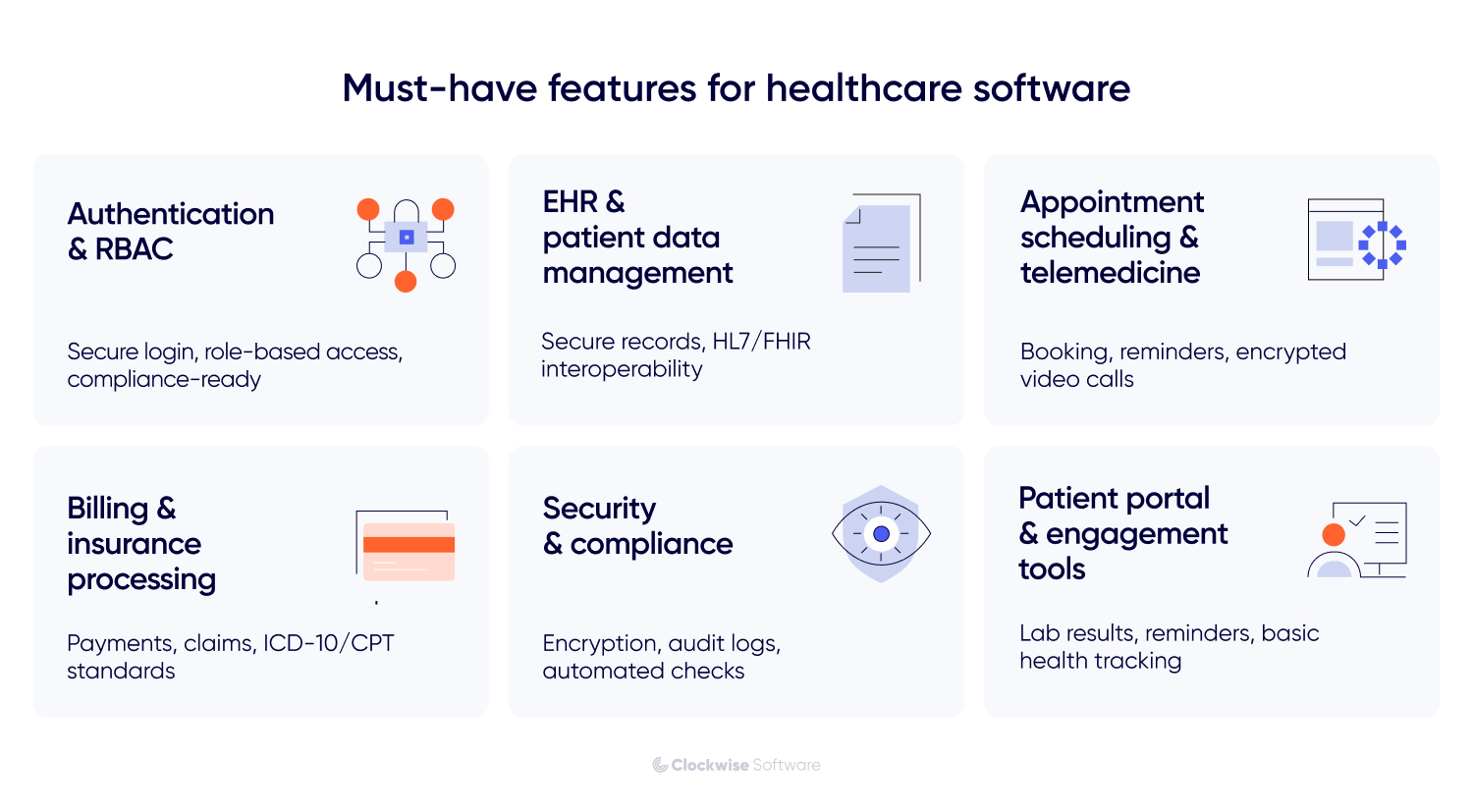
User authentication & role-based access control (RBAC)
Strong access control is the backbone of telemedicine app development. Patients, doctors, nurses, and admins all need different levels of visibility. The system has to protect sensitive medical data without making logins a hassle.
-
Secure login. Multi-factor authentication (MFA) lowers risks from stolen or shared passwords.
-
Role-based permissions. Each role sees only what it needs. Doctors access patient histories, patients see their own records, and admins handle usage or billing data.
-
Compliance built in. HIPAA, GDPR, and SOC 2 all require strict access rules. Role-based access control (RBAC) makes your app not just secure, but audit-ready.
We’ve done this across very different projects. For Heads Up, we combined role-based access, secure authentication, and HIPAA compliance with ongoing scaling. In a route planning system, we tailored access by role and department, and gave drivers an NFC-based login to replace manual entry, making sign-ins quick and error-free. For a municipal project management platform in Ireland, we integrated Windows AD authentication, enabling safe collaboration across multiple departments.
Electronic Health Records (EHR) & patient data management
Modern healthcare software development solutions are defined by how effectively they manage patient data. Doctors need fast, reliable access to histories. Patients want a clear view of their own health. And compliance demands secure storage and exchange.
-
Secure storage and retrieval. Centralized access to medical histories, prescriptions, lab results, and imaging reports.
-
Rich data inputs. Support for uploads from labs, wearable devices, and external health apps.
-
Interoperability. Compliance with HL7 and FHIR standards for seamless data exchange across healthcare systems.
For example, when working on Heads Up, we built a dynamic patient table that aggregates data from wearables, third-party apps, and manual inputs, giving clinicians flexible views to track progress against benchmarks or drill into specific metrics. We also developed tools for managing lab results, allowing patients and practitioners to enter biomarker data, visualize it with dynamic charts, and export records in CSV or PDF formats for sharing or long-term monitoring.
Appointment scheduling & telemedicine integration
For patients, convenience and accessibility are now baseline expectations. Users want to book visits without phone calls, and providers need secure, reliable ways to deliver care remotely.
-
Online booking system. Patients schedule visits directly in the app, with calendar integration to prevent conflicts.
-
Automated reminders. Notifications reduce no-shows and improve patient adherence.
-
Telehealth module. Virtual consultations and remote monitoring extend care beyond clinic walls.
-
Secure video conferencing. End-to-end encrypted calls protect sensitive discussions and meet healthcare regulations.
For every product, we shape these features in its own way. In Namaster, a medical cannabis consultation app, doctors needed a secure way to connect with patients online. We integrated Vidyo for encrypted video calls and built the telehealth flow around it, so care could happen remotely without friction. In Toddy, a childcare marketplace, the priority was smooth scheduling for busy parents. We connected the app with Google Calendar and designed a booking flow, the same logic that later proved essential in medical appointment systems.
On Option House, a real estate platform, the challenge was fairness: users wanted confidence that their reserved slots wouldn’t be double-booked. We solved it with a time-slot reservation system, an approach we now reuse in healthcare scheduling. And in RemoteWorx, a wellness app, the focus was long-term engagement. We added automated reminders and messaging, small nudges that kept users on track with healthier routines.
Read also: How to Build a Minimum Viable Product (MVP)
Billing & insurance processing
Not every healthcare app needs billing and insurance at launch. But when they do, we know how to build them right. Over the years, we’ve developed modules for healthcare software implementation that cut admin work, reduce errors, and keep payments moving without delays.
-
Automated insurance claims. Built-in submission and verification reduce paperwork and delays.
-
Payment processing. Support for both patients and insurance providers, with flexibility for local and international gateways.
-
Standards integration. Compatibility with ICD-10, CPT, and HL7 FHIR ensures your billing system works seamlessly across the healthcare ecosystem.
Stripe is often our go-to for payments: it’s flexible, customizable, and covers most scenarios, from one-time charges to subscriptions. We’ve integrated it in projects like Workerbee, Strapping, Knocking, and Creadoor, setting up recurring payments, automated payouts, and split billing depending on the flow each product needed.
For apps targeting global audiences, PayPal can be a solid option. We connected it in EmailMeForm to handle international payments smoothly. And when a project calls for a regional provider, local gateways also work. In Toddy, a childcare marketplace in Australia, we integrated Pin Payments to support users with familiar, trusted payment methods.
Security & compliance features
In healthcare, trust is built on security. Patients, providers, and regulators expect sensitive data to be protected, traceable, and compliant with strict standards. A strong security foundation helps you prevent breaches, avoid penalties, and protect your reputation.
-
End-to-end encryption. Protects patient data both in transit and at rest.
-
Audit logs and access tracking. Every login, change, or record view is logged to detect unauthorized access.
-
Automated compliance checks. Keeps the system aligned with evolving requirements like HIPAA, GDPR, and SOC 2, without relying on manual oversight.
We applied these principles in the BackupLABS project, where we implemented end-to-end encryption using AWS S3 Encryption Client and AWS KMS for key management. This ensured all encrypted client data was stored securely on Amazon, inaccessible even to the development team. For healthcare, we follow the same principle: choose security measures that fit the product’s compliance requirements.
Patient portal & engagement tools
Simply showing results sometimes isn’t enough; patients want tools that make the data useful in everyday life. A well-designed portal drives patient engagement, supports better outcomes, and builds long-term loyalty.
-
Secure access. Patients can view lab results, prescriptions, and doctor notes in one place.
-
Smart assistants. Chatbots or AI modules handle reminders and FAQs, reducing the load on support staff.
-
Health tracking & medication reminders. Tools that support chronic disease management and improve adherence.
We saw this in our healthcare software development work on Heads Up. The first patient portal showed lab results in a simple color-coded table. Feedback revealed patients wanted a more interactive way to use their health data. We redesigned the experience with a cleaner UI, easier manual data entry, and export options in PDF, giving patients not just access, but real control over their information.
Must-have features give you a safe launch pad. The next layer comes with enhancements that aren’t critical for launch, but can set your product apart as it scales.
Nice-to-have features
Once the essentials are in place, it is time for add-ons that make your healthcare product more engaging and competitive. These aren’t critical for launch, but they can set your platform apart, improve retention, and open new revenue streams as you grow.
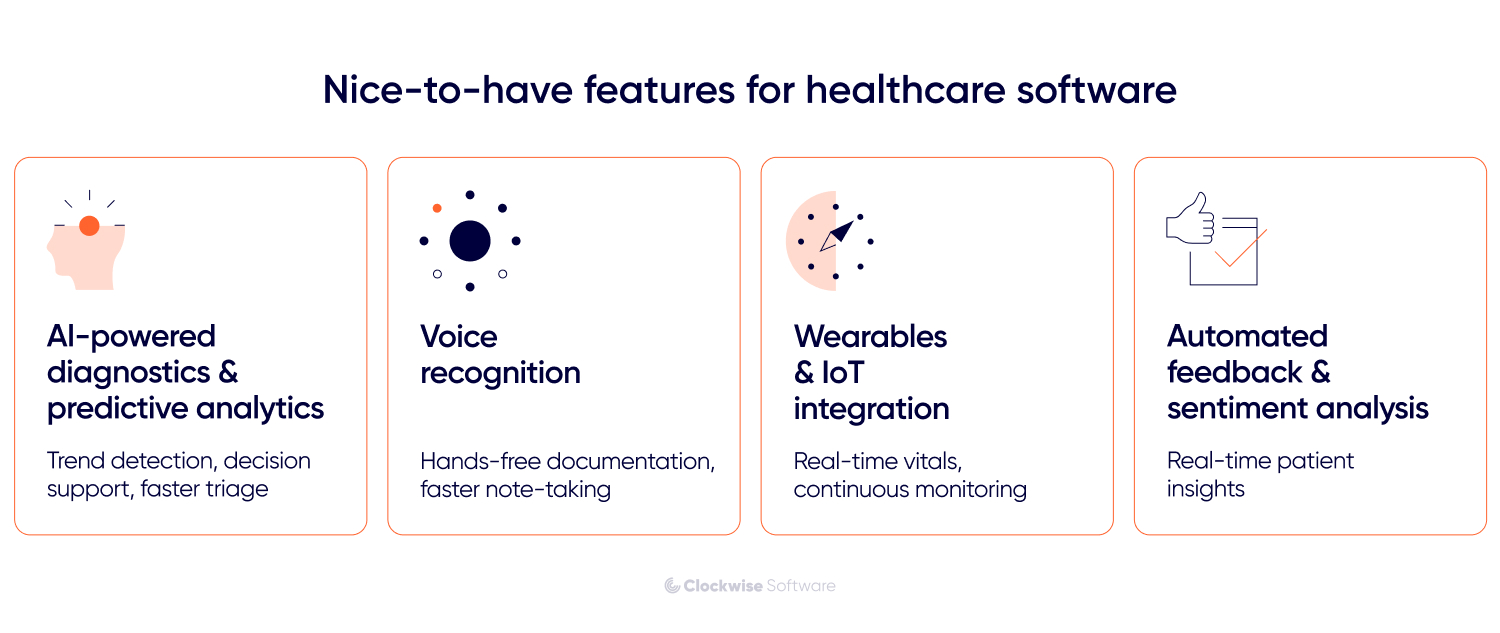
AI-powered diagnostics & predictive analytics
AI won’t replace doctors, but it can take a lot of weight off their shoulders. Instead of digging through lab results line by line, models can surface what matters, flag anomalies, and point out high-risk cases in seconds. Some models even cut internal medicine diagnosis time by almost half, giving clinicians more space to focus on patients instead of paperwork.
As your platform collects more data, AI can also start looking ahead. Predictive tools can spot patterns that show who might develop a chronic condition or who needs early care. In one large-scale study of 1.5 million patients, this kind of approach helped reduce hospital stays by 12 hours. That’s the difference between an app that tracks health and one that actively prevents problems.
Voice recognition for hands-free data entry
Typing notes mid-shift is nobody’s favorite job. Voice recognition lets doctors and nurses dictate directly into the system, saving them up to 90% of that admin time. In your app, this could mean faster documentation during rounds or hands-free inputs in busy clinics. It’s not essential for an MVP, but if your target users spend hours writing notes, adding voice input is one of those “quality of life” upgrades that makes them stick around.
Integration with wearables & IoT devices
By connecting your platform to wearables or IoT sensors, you can track vitals, activity, or medication adherence in real time. For patients, it means a richer view of their health; for providers, it’s continuous monitoring instead of fragmented check-ins. Yes, it adds technical and compliance complexity to healthcare software development, but if your vision is continuous care rather than one-off visits, wearables turn your app into a daily companion.
Automated patient feedback & sentiment analysis
Collecting feedback is good; making sense of it at scale is better. With automated sentiment analysis, your app can scan reviews, surveys, and support tickets to surface recurring issues or positive patterns. For your product, this means you won’t have to wait for a quarterly survey to learn what frustrates patients. They leave a comment, the system picks it up, and you get real-time insights to improve workflows and communication. Over time, this builds patient trust and loyalty without adding manual work.
Extras can strengthen your product, but only when added at the right time. A clear prioritization process keeps healthcare software development lean and strategic.
How we help clients prioritize features
One of the biggest risks in healthcare software development is trying to build everything at once. The result is often blown budgets, delayed launches, and features nobody uses. We keep things lean with this process:
-
Start with discovery workshops. Map business goals, user needs, and compliance requirements.
-
Prioritize for launch. Based on our healthcare software development experience and your goals, we’ll suggest which features are worth building first and which can safely move to the next iteration.
-
Build an MVP. Core features like authentication, patient data management, and scheduling.
-
Iterate with evidence. Refine feature backlog and further development plans using real feedback and usage data.
This way, every feature serves a clear purpose: improving patient outcomes, supporting providers, or strengthening the business model. You move faster with confidence, knowing your roadmap is evidence-based and built to last.
Let’s plan a scope smart, so every feature has a purpose.
We keep the focus sharp, the budget lean, and CPI/SPI variance under 10%.
Clear priorities mean healthcare software development with no wasted effort and no wasted budget. With the scope set, we can finally answer the big question: what will it take in time and money?
Healthcare development cost and timeline
The software project estimation of building a healthcare product depends on scope, integrations, and compliance requirements.
-
MVP build. A lean version with core features like authentication, patient data management, and scheduling usually takes 4–6 months and costs $70,000–$120,000.
-
Full-featured platform. Adding telemedicine modules, billing, and integrations with EHRs or wearables extends the scope to 6–9 months, with budgets in the $150,000–$250,000 range.
-
Enterprise-grade system. Multi-region support, predictive analytics, AI software development to power diagnostics, and complex compliance workflows typically require $250,000+ and a longer roadmap.
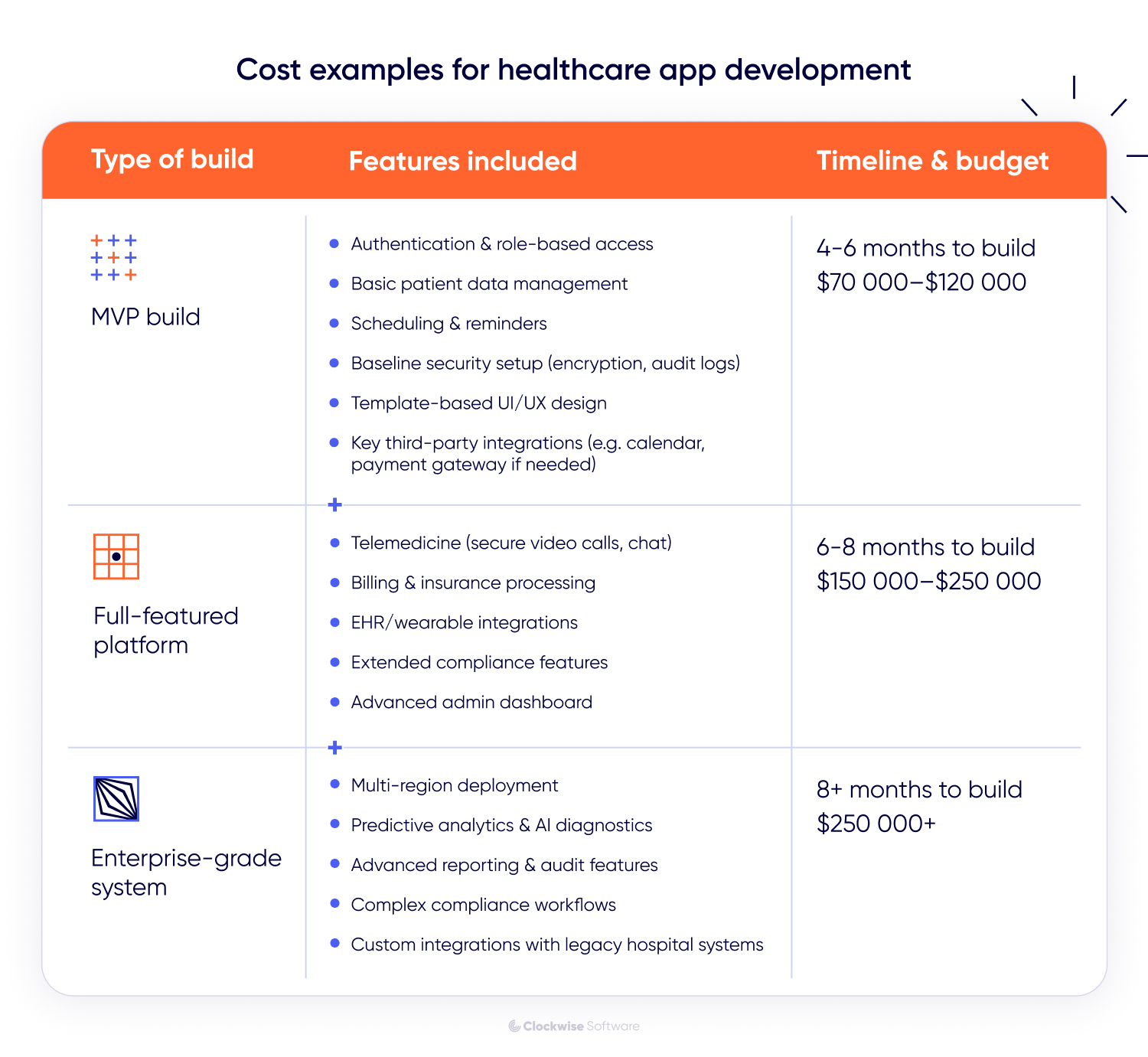
We know these numbers hold up because we’ve delivered them before. By starting healthcare software development with discovery and prioritizing the right features, we help clients avoid overspending on what doesn’t matter and invest where it brings the most impact.
Post-release support and improvement
Launch day is a milestone, not the destination. In healthcare, products need ongoing attention to stay compliant, stable, and valuable for users. That’s why top healthcare software development companies treat post-release as an active stage of development. What this stage includes:
-
Monitoring and maintenance. Tracking performance, uptime, and security events to catch issues before they affect patients or providers.
-
Compliance updates. Adapting to new regulations (HIPAA, GDPR, SOC 2) so your product always stays current.
-
Feature refinement. Improving usability and workflows based on real-world clinician and patient feedback.
-
New functionality. Adding modules and features depending on how you want to improve the product, from extending workflows to enhancing usability or scaling for new users.
-
Continuous testing. Regression tests and audits ensure every update runs smoothly without breaking existing features.
Unlike consumer apps, healthcare platforms can’t afford downtime or lapses in compliance. Ongoing support keeps your product aligned with user needs, regulatory changes, and innovation, without risking patient safety or provider trust.
Post-release development costs
In software development for healthcare, post-release costs vary widely: some teams focus on light maintenance, while others invest in continuous feature development and scaling.
A small maintenance team with 1-2 developers, plus on-demand support from a PM, analyst, and designer, typically costs around $12,000/month. Larger teams with multiple developers, QA, and a designer scale to $48,000/month, supporting faster growth and feature expansion.
A typical support setup looks like this:
| Team composition | Monthly budget |
|
$12,000 |
|
$48,000 |
| * On-demand involvement | |
Good post-release care keeps your product safe today and adaptable for tomorrow.
Choosing the right development team for your healthcare project
How you organize healthcare software development has a direct impact on speed, costs, and control. We usually work with clients in one of 3 models, each fitting a different stage or need.
-
Full-cycle product development. You bring the idea, and we handle everything else: discovery, design, development, and post-release support. Best if you want to outsource healthcare software development to one experienced team that will own the whole process while keeping you in the loop.
-
Dedicated development team. A self-contained team (backend, frontend, mobile, QA, PM if needed) that works as your remote extension or just extra hands that cover talent gaps in your in-house team. You can hire dedicated developers and get predictable capacity and expertise without the overhead of hiring full-time.
-
Discovery phase. Have an idea but not sure what features your software should include, how they should work, what tech stack to choose, or how much time and money it will take? Discovery with a healthcare software development company will give you clear answers before you commit to a full build.
Choosing the right healthcare software development team structure gives you flexibility and expertise without overspending or slowing down.
Conclusion
Healthcare software development is complex: compliance rules, sensitive data, and multi-role workflows demand precision at every step. What makes the difference is a clear process, the right features at the right time, and a team that knows how to build products from scratch and support them for years.
We’ve built more than 10 healthcare platforms, including long-term partnerships where we’ve refined and scaled products over several years. That experience taught us how to balance speed, stability, and compliance without compromising on user experience, and we can bring the same approach to your product.
We’ll help you build a healthcare app without falling into the usual traps.
Our team navigated them 10+ times already, designing, building, and supporting apps that teams rely on daily.
FAQ
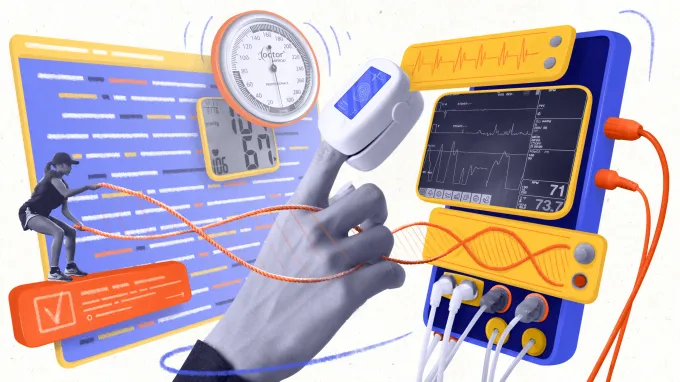
Any questions unanswered?
Let's discuss them
